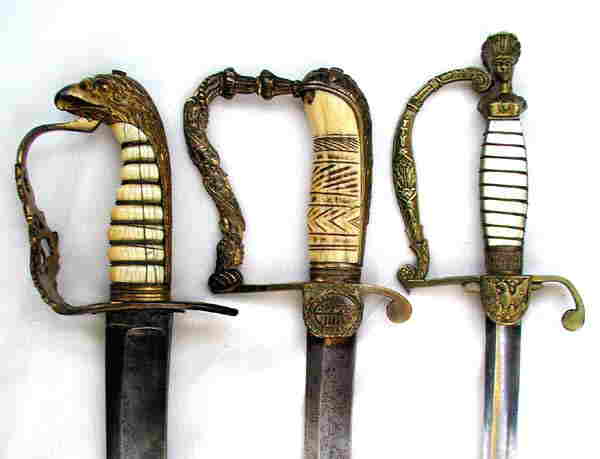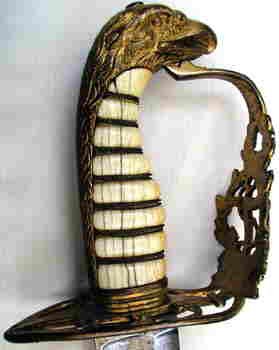|
3
SWORDS IN TWO PARTS
|
|
THIS WEEK IS
THE SECOND (AND FINAL) WEEK IN WHICH WE WILL BE LOOKING AT 3 DIFFERENT
AMERICAN MILITARY OFFICER'S SWORDS FROM THE EARLY 1800'S. EACH
SWORD IS FROM A DIFFERENT BRANCH OF SERVICE. FROM LEFT TO RIGHT
FOLLOWING ARE NAVY, MOUNTED ARTILLERY AND INFANTRY OFFICER'S SWORDS.
THEY DATE, RESPECTIVELY, FROM APPROXIMATELY 1808 TO 1850.
|

|
|

|
|
Left
to right: Naval Officer's Eagle Head Sword 1808-1830, Mounted
Artillery Officer's Sword 1815-1840, Infantry Officer's Indian
Head Sword 1835-1850 (All dates approximate).
|
|
|
PART 2 - Sword
1 of 2
|
|
NAVAL
OFFICER'S EAGLE HEAD SWORD
|
|
1808-1830
|

|
|
This sword measures 35¼" overall. The 30" curved, single
edged blade has a shallow broad fuller that extends from the ricasso
to within 9" of the blade point. At the hilt, the blade is 1-3/8"
wide and 5/16" thick. It is 1¼" wide for most of it length
before tapering gracefully to it's point. There is no true false
edge. The ricasso measures only 3/16". The blade is without decoration
or scabbard. There is no maker's name or mark visible. The plain
blade gives no indication of ever being engraved or heavily cleaned.
|
|
The grips are carved ivory with 1 twisted and 2 single strands of
gilded wire windings encircling the ivory grooving. A large fouled
anchor cutout, within the lower part of a decorative figure 8 floral
cutout, has been cast into the reverse P pattern knuckle bow. The
flat oval shaped hand guard, which is part of the same casting,
is separated into eight sections with curved brass branches extending
between the outer and inner parts of the hand guard.
|
|
The eagle head pommel design extends down the grip back strap in
the form of incised eagle feathers. All brass parts of this sword
were originally gilded and much of that gilt is still in place today.
|
 |
 |
|
Obverse
View of Hilt
|
Reverse
View of Hilt
|
 |
 |
 |
| Knuckle
Guard Design
|
Back
Strap
|
Top
of Hand Guard
|
|
 |
 |
| Eagle
Head Pommel
|
Close
Up Of Anchor
|
|
| PART
2 - Sword 2 of 2
|
| INFANTRY
OFFICER'S INDIAN HEAD SWORD
|
| 1835-1850
|

|
|
This sword is 35-1/16" overall. The 29-5/8" straight, single edged
blade with a false edge of approximately 14" has a wide deep fuller
from the ricasso to the beginning of the false edge. At the hilt,
the blade is ¾" wide and ¼" thick. It tapers evenly
to it's point. The ricasso measures ¾". The blade is without
decoration and does not appear to have had any initially. There
is no visible maker's name or mark.
|
|
The grip is comprised of two pieces of mother of pearl fastened
to a wood core. These panels are incised with grooves to hold the
gilt twisted wire wrapping. The top of the mother of pearl panels
is fitted within the base of the Indian maiden pommel. The bottom
is contained by a decorated brass ferrule. The pommel is a cast
brass bust of a female Indian maiden, with a circular headdress,
facing the obverse or front of the sword. She is wearing a large
circular medallion which causes some references to this sword as
having an Indian “Princess” rather than an “Maiden” head pommel.
The knuckle bow is of a baroque design which is attached at the
Indian's ear and curves downward to the end of the hand guard opposite
the turned down quillon. It is decorated with floral scrolling.
There is no real counter guard, only an oversized langet on each
side of the hand guard decorated with the federal eagle carrying
arrows in the left talon and the peace branch in the right talon.
All metal parts of the grip are brass.
|
 |
 |
| Obverse
View of Hilt
|
Reverse
View of Hilt
|
 |
 |
| Indian
Maiden Close Up
|
Langet
Close Up
|
|
|
The brass scabbard is incised on the obverse only with floral scrolling
at the mouth, rings, stud and drag, the drag being more of a ball,
than a skid. The suspension consists of 2 brass carrying rings with
the top ring being 2-1/8" from the scabbard throat and the lower
ring 7-3/16" beneath the first. There is also a single shield shaped
stud for attachment to a frog. It could be carried in either manner.
This scabbard is missing it's throat. Other than that, it is undented
and unscratched.
|

|

|
| Top
Ring And Frog Stud
|
Lower
Ring
|

|
|
Scabbard
Tip
|
|
|
Notes
|
|
In truth, the second sword in this posting could have been carried
by an officer of any branch of service. The regulations were so
written as to allow almost any officer to wear anything. This plus
the officer's financial position and personal tastes dictated to
some degree what they would buy. Militia officers showed a disdain
for any regulations and if they just happened to like Indian Princess's,
that's what they bought whether they were staff, field, infantry
or artillery. Navy officers also wore swords of the Indian Maiden
design.
|
|
Reference credits go, again, to “THE AMERICAN SWORD, 1775-1945"
by Harold L. Peterson and the posting credits go, again, to my son,
Reed Radcliffe, the webmaster.
|
|
Well, I don't know what next weeks posting will be. It could be
almost anything. I still have a way to go.
|
|
See you all next week. Drive carefully and securely. You can forget
your wallet and get away with it, but if you forget to buckle up,
you may never have another opportunity to forget anything else...
and you will never know if you cared or not.
|
|
Someone, somewhere does care........ Buckle Up!
|
| Dave
Radcliffe
|

















